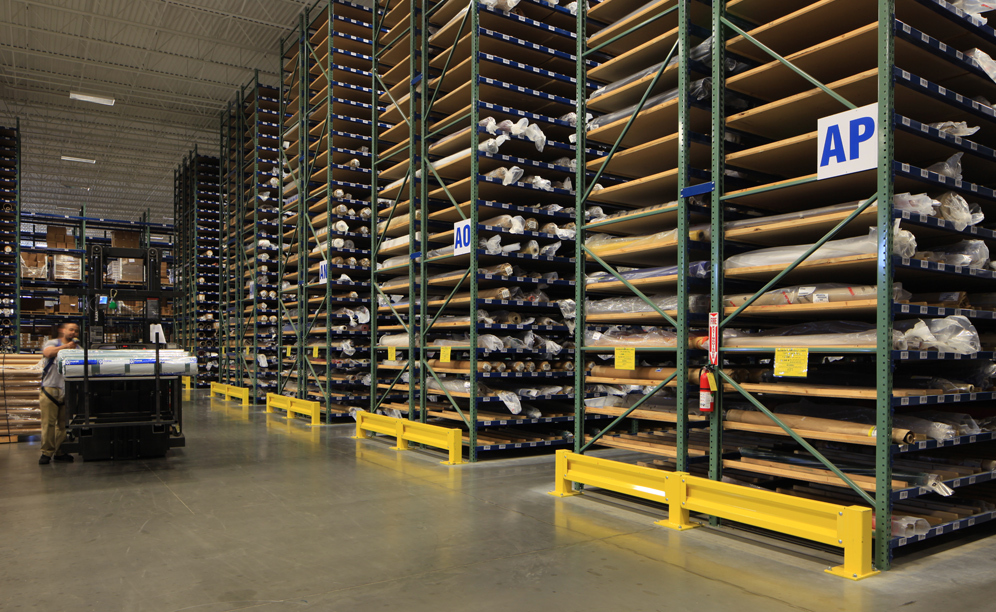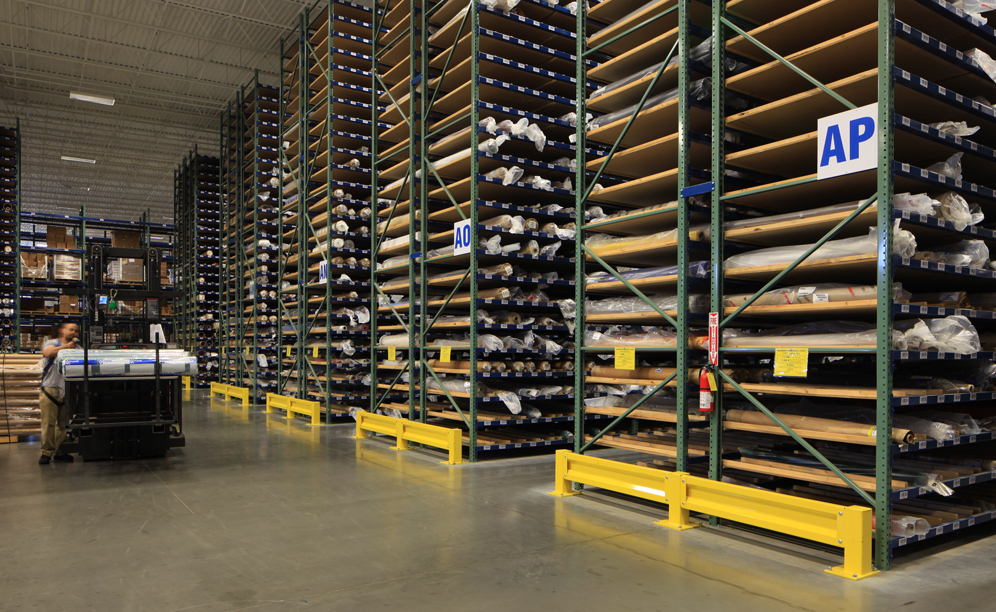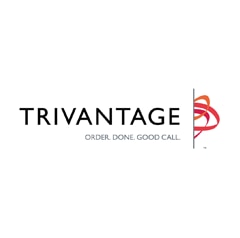
Just as there are three times the shelves of a normal bay packed into Trivantage’s system, there are also five-times more pallet positions

Trivantage, Rolling with an Idea

Using Interlake Mecalux rack was just one in a chain of ecological decisions made by Glen Raven in the construction of the Mebane, N.C., Trivantage warehouse. Throughout the process, they had sustainability on the mind. This is what earned them their LEED Silver certification and, with their 100,000-square-foot space, the claim as the fourth largest LEED certified building in existence. This project was no small undertaking. Glen Raven made choices for its new building in Mebane that reduce energy consumption, improve air quality and make it an all-around more comfortable place for employees to work and customers to do business. They have laid the groundwork for a successful next 100 years, and Interlake Mecalux is proud to have rack standing on that ground.
Density is the first thing one notices about the towering racking system in Trivantage’s North Carolina distribution center in Mebane. There are three times more shelves than in most normal units. This means that the second thing one notices about the racking system is how unique it is. Extending imposingly 30 feet in the air, thousands of fabric rolls bunk in shelving compartments like crayons in a box. It is immediately clear that more than a little engineering went into the design of this facility.
In 1969, United States astronauts took mankind’s first steps on the moon and sank their country’s flag eight inches into the surface to honor the feat. That flag’s fabric was woven by a North Carolina company named Glen Raven, known more for making pantyhose than historical textiles. This was just one event in the history of a company with diverse and wide-ranging accomplishments.
Glen Raven got its start as a cotton awning manufacturer in 1908. Throughout the 1940s, with World War II raging, Glen Raven found its niche manufacturing military parachutes. The company continued growing and shifting and eventually developed the first commercial ladies pantyhose in 1959. Three years later, the company introduced an acrylic-based fiber more durable than cotton which put Glen Raven back into the primary role of manufacturing fabric – a role that it has maintained ever since. Today, in addition to making awning and boat covers, Glen Raven and its subsidiaries make convertible tops and outdoor canopies, and they supply many of the hardware pieces that complement their fabric line.
Between 1998 and 2008, the company merged with France’s Dickson SA and acquired two American companies. The French merger gave Glen Raven a presence throughout Europe and China, while the American acquisitions led to another development. Glen Raven, along with the more than 130-year-old Cleveland-based Astrup Company and the more than 140-year old Brooklyn-based John Boyle & Company, combined their considerable experiences (and considerable advantages within the market) to form the triple-headed super-subsidiary named Trivantage.
Trivantage, unlike Glen Raven, was created to focus on the distribution of fabric rather than its production. It didn’t take long for the newly formed company to realize how different the two functions are. Less than 18 months after its formation, Trivantage began retooling its processes.
Lee Whitney, the company’s vice president of finance administration, said the economy’s downturn largely spurred the company to reconsider not only how it had been performing operations in the last year-and-a-half, but also how the two acquired companies had handled distribution over the last century.
According to Whitney, the company decided it needed to regard its value in the manufacturing chain differently than other distribution centers. “A manufacturing company might have a roll of fabric; let’s say 50 yards,” Whitney explains in a Carolina-soaked drawl. “Well, not everybody needs 50 yards of fabric. A lot of times, only five or eight or 15 are necessary. Our role is to take the manufactured goods and sell it to the end-user in whatever dimensions he needs.”
In order to fulfill such a wide range of orders, the storage warehouse must not only be able to hold tens of thousands of fabrics (the North Carolina facility has space to store more than 50,000 fabric rolls), but also be able to locate a specific roll quickly. As Whitney explains, “You can’t just point to a bin location and say, ‘Okay, pick one of these.’”
Trivantage remains the only national distributor of the types of fabrics Glen Raven manufactures, and its Mebane distribution center was the first such facility in North Carolina to be fully LEED certified. Each year the company brings its bulk supply in, breaks it up into thousands of individual SKUs and deals them out to hundreds of its vendors around the U.S. Typically, if a customer places an order today, they want it tomorrow. In order for a distribution center in North Carolina to fulfill an order on its way to Texas with that kind of efficiency, its employees cannot afford to spend three minutes rooting around fabric stacks aimlessly hoping to find the necessary product.
The Mebane distribution center serves two separate-but-equal purposes. The first is to replenish the 11 other branch locations throughout the country. The second is to process and ship orders directly out of the warehouse. “It’s a distribution center,” Whitney reminds us. “Our main goal is to move items, not just store them.”
Before the retooling effort, it would not have been out of the ordinary to find a couple dozen 25-pound fabric rolls stacked in a compact area ready to be tugged out when needed. This practice left many rolls frayed, dented, with unnatural ridges, essentially destroyed. “That [storage method] wasn’t going to work with our volume,” Whitney says, adding that the immense product volume prompted the company to consider alternative methods of storage and location tracking. Trivantage hired consulting firm Tompkins International to take charge of the operation. Tompkins had an idea of the rack layout necessary for their client’s end-goals but struggled to bring that idea to fruition. “That’s when [Tompkins] started talking to all kinds of different vendors,” Whitney says. “They had a wide range of companies bidding on this project and trying to develop a solution; from racking people and design engineers to fabricators.” After a number of failed approaches, Tompkins found a company with an answer. Interlake Mecalux had a big idea.
Trivantage needed to store an immense number of fabric rolls and aimed to do so in an unusual way. The company wanted single-selectivity storage so that their distribution center could more easily access a single fabric roll, bring it down, cut it, and put it back. Most companies that don’t store rolls on carousels tend to stack the product pyramid-style, forcing personnel to move product at the top of the heap in order to reach the products on the bottom. Not only was it necessary to store the rolls on a smooth surface, but they were to be stored without the use of the commonly used cardboard tubes.
In most operations, the wax-lined cardboard tubes that held each fabric roll like chips stacked in a Pringles can, would wear out and force users to repurchase new tubes at $10-15 a pop. In addition to the costs of the tubes, clients also added to their fire risk by storing flammable fabric into a cardboard coffin, making each product twice as flammable, not to mention the extra space each tube occupied in multiples of hundreds or thousands.
The tube solution, according to Karl Borgman, the Tompkins project manager in charge of equipment purchases, was completely off the table. Instead, Tompkins solicited several metal fabrication shops for ideas on how to better store the fabrics. The best idea to come from this was a half-moon cradle-type metal pallet that could have been made from either steel or aluminum. Either way, the price to manufacture and ship them was unthinkable.
“At the time, it was the only solution we had,” Borgman says, recounting that after the metal fabricators, Tompkins shopped the prototype around to different rack vendors. “We said, ‘Here’s the solution we’re planning on using. If you have a better one, please provide it to us.”
Everyone was searching for a way to store 50,000 rolls of fabric individually without the damaging stack-and-tug methods of yesteryear. According to Mark Tomko, a Midwest sales rep for Interlake Mecalux, Tompkins invited IK MX to take a stab at finding a solution. The result is not a complicated design, but it is a new one. Each flat wooden deck rests comfortably on the frame’s beam like a wire or galvanized deck usually would. Long rectangular wooden dividers – sometimes called “cleats” – create about a foot of space for the fabric to rest without rolling to either side. Each deck is large enough across to fit five fabric rolls. Whitney described the design’s end result as resembling the plastic supermarket partitions placed between bundles of groceries at the checkout line. “It’s so simple,” Tomko says, slightly lamenting the fact that the eventual solution isn’t more visually impressive, “but the simplest ideas are sometimes the coolest. When you show it to somebody they’re going to ask, ‘What’s so special about that? It’s just a board with separators on it.’ It doesn’t look like a big deal, but for a company that had damaged fabrics and trouble tracking them, this is a great solution.”
The design may have been simple enough that anyone could have come up with it, but no one else had. “Interlake Mecalux was the only vendor that came back with anything other than what we said we would do,” adds Borgman. “None of [the other companies solicited] provided us with any other benefit. Interlake Mecalux came back with a solution I didn’t even know about.”
Tomko, for his part, was careful to add that innovation was only half of it. “We were a lot less expensive too,” he says. Most of the rejected designs involved $500 metal pallets that did little to protect the product. Tomko’s plan, if enacted, would protect every individual roll and saved hundreds of thousands of dollars along the way.
“I looked at Tompkins’ metal pallet plan and thought, ‘that’s going to cost millions of dollars.’ There was no way. “I have to credit Tompkins for doing a lot of the work to get to a point where they brought me in,” Tomko says. Borgman knew that the half-moon pallets weren’t an optimal solution, which is why he jumped on the Interlake Mecalux wood design, noting that reconfiguring a system filled with wood is better than having to replace steel or aluminum.
The next step for Interlake Mecalux was to determine how to produce 5,000 specialized wooden decks as inexpensively as possible. After a brief search for wood companies capable of the job, Interlake Mecalux partnered with Cornerstone Wood to produce the decks, a job the Oregon-based company jumped into with both feet. The wood manufacturer admitted they had never been asked to build industrial particle shelving with as heavy of a load in as long a span as Interlake Mecalux had initially designed, but their confidence never wavered. “[Cornerstone] is willing to do strange things,” says the company President Greg Doppler. “The more technical it is, the more involved it is, the more design there is, the more we like it.”
Cornerstone brought four different layouts of each of the two proposed prototypes to Tompkins’ North Carolina facility and every faction convened to fine-tune the solution. Tompkins, Interlake Mecalux and Cornerstone – with cooperation from Trivantage – began testing for weaknesses in the design or issues that might develop during use. The four companies had to collaborate in order to hammer out a number of issues, the most pressing of which was preventing shelf deflection. Cornerstone first considered constructing the shelves out of plywood, which would have been structurally stronger, but more expensive and prone to splintering and chipping when in contact with the fabric. The wood manufacturer determined that the shelves would need something extra. “The shelving by itself was not sufficient to do the job,” Doppler says.
Borgman, with a resolved laugh borne from hindsight adds, “Lo and behold, the client decided to put rolls on the decks that were heavier than expected in those locations.” The decks bowed on the beam and punched through the wooden support. Simply screwing the separators to the deck proved not to be secure enough to get the job done. Gluing and screwing the shelf cleats into place, it turned out, offered considerably more strength to the shelving system, creating not only a deck divider, but also a significantly stronger non-deflecting deck. Another issue in need of attention was how to make each deck smooth enough to allow the fabric to slide in and out easily. Doppler vaguely described this solution as a manufacturing process that involves a product similar to medium density fiberboard. He then jokingly halted and cautioned that if he revealed any more he’d have to take this reporter out back and shoot him. No further questions on the matter were posed.
As Doppler explained, sometimes solid plans on paper don’t always work when replicated using composite materials with unique loads in the actual field conditions. Whitney adds, “Several iterations seemed logical until we went out and tested it. The things we came up with didn’t end up allowing the fabric to slide, or it shred the fabric.”
The team spent a month tweaking the design to ask and answer several questions. How round the edges should be? How much end space was necessary to comply with state and federal fire codes? Are the rolls able to slide smoothly? Can the decks handle the weight of the fabrics?
Cornerstone even set up a makeshift woodshop at the Tompkins site, complete with a router and spare pieces, making adjustments to the wood prototypes on site until the right product was formed. It wasn’t easy. “It was about 98 degrees outside,” Doppler recalls. “We were sweating ridiculously. It was disgusting out there, but it was a lot of fun because everybody pitched in and was committed to a solution.”
The skyscraping storage bays in the Trivantage facility are so dense that each fabric roll appears like a light in a grand scoreboard. Just as there are three times the shelves of a normal bay packed into Trivantage’s system, there are also five-times more pallet positions. In short, the storage was very dense. In addition, the fabric rolls aren’t manufactured in standard lengths; some extend past five feet, while others come in under four.
This was another consideration in the design of the racking layout. It was important to keep items of similar length (and weight) grouped together to create a more efficient system of storage while also maintaining the preciousness of the fabric. Not every bay carries the same 18-inch distance between shelves; some are wider to handle larger or heavier fabric rolls. Generally, however, the system is built for maximum density, while maintaining the most efficient method of locating specific fabrics. The Trivantage facility is an automated paperless operation in which fabrics are listed in its WMS. When a specific roll is needed, the determining descriptors are entered into the system and the roll’s location is listed. What makes this distribution center hum is the ease with which each roll is accessed after it has been located. “It’s a very quick process,” Whitney says. “It’s a matter of scanning it in, pulling the roll and moving onto the next location. If we didn’t have the racking system, [finding fabric rolls] would be more cumbersome and time-consuming.” As it is now, the product picking procedure has been streamlined in a way none of the other Trivantage facilities were allowed to operate before. Now, pickers take routes within the warehouse that are geographically lumped together.
The picker then unloads the wave and goes out to start a new one in a different section.
Interlake Mecalux understood the importance of product accessibility in a warehouse, especially in one placing so much emphasis on fast turnover. IKMX, Cornerstone and Tompkins created a solution for Trivantage’s storage that became a solution for the rest of the facility’s ailments.
In fact, the solution has carried over into other installations with other companies, according to Borgman. “Quite frankly, we didn’t realize you could do a beam that narrow. I recently did a project in Canada and they had beams on 3-inch centers and I said, ‘Good grief, guys. This is annoying!’ It made me appreciate 2-inch centers,” Borgman explains. He expounds a bit more on this watershed moment in storage innovation and one wonders if Glen Raven might add this to their marketing materials next to the images of Armstrong and Aldrin planting the flag on the moon.
“[Interlake Mecalux] did a hell of a job putting this thing together,” Doppler says today. “They did what not one-in-a-hundred people would have done for [Trivantage]. They really helped the customer.”
There are no stopgaps in the IK MX product line. Whether it is something they’ve been doing for decades, or something new, the solutions from Interlake Mecalux are permanent; the success on display in Trivantage’s distribution center proves this. “I like to think that we need each other in processes like this,” Whitney says. “We couldn’t have done it without Interlake Mecalux.”
| Cantilever and High-height Selective pallet rack | |
|---|---|
| Facility size: | 100,000 sq. ft. |
| Special rolled fabric decks: | 5,000+ |
| Rack height: | 30 ft. |
| Row clearance: | 18 inches (1.5 ft.) |
| Deck width: | 5 ft. |
| Partition width: | 1 ft. |
| Clear Ceiling Height: | 30 ft. |
| Average weight of fabric rolls: | 20-30 lbs. |
Ask an expert